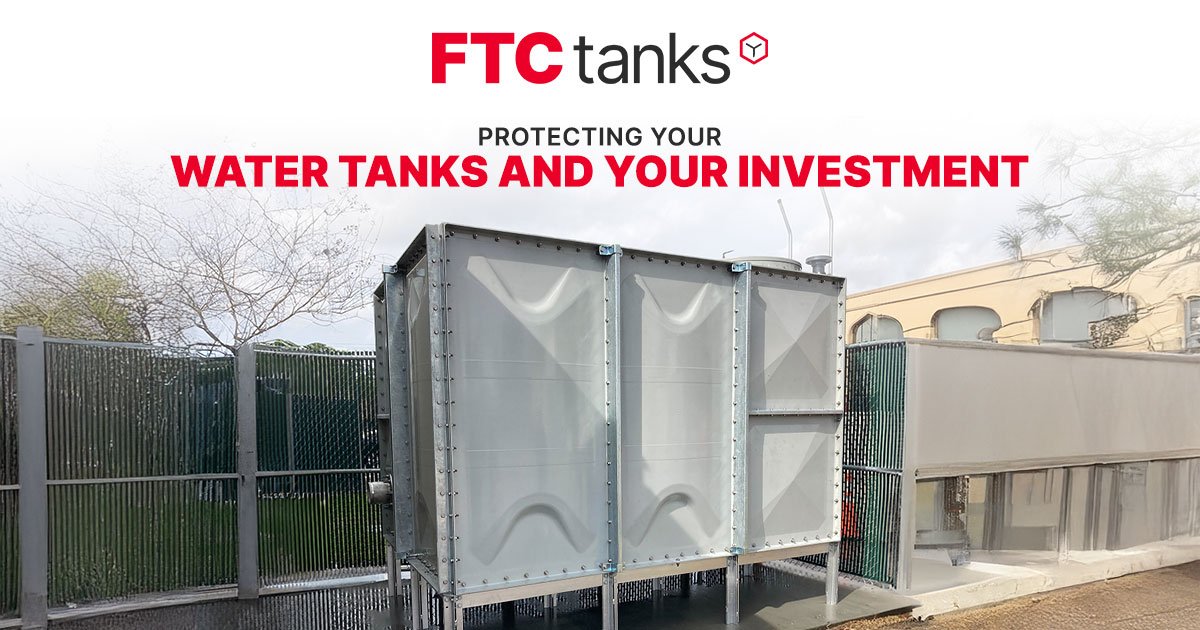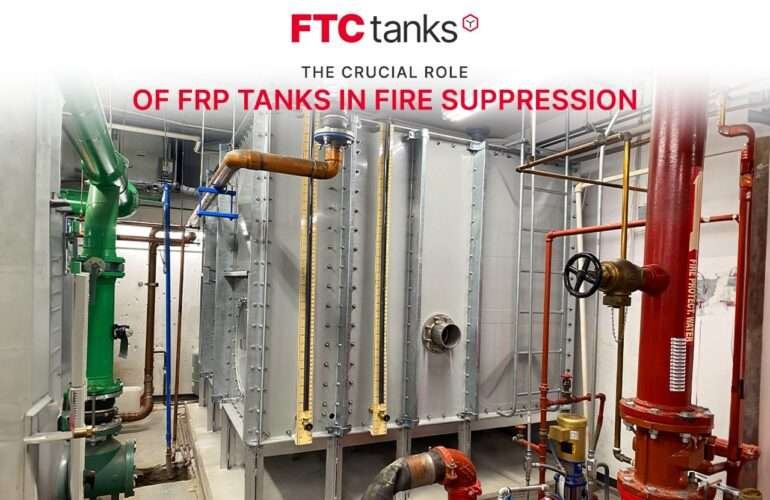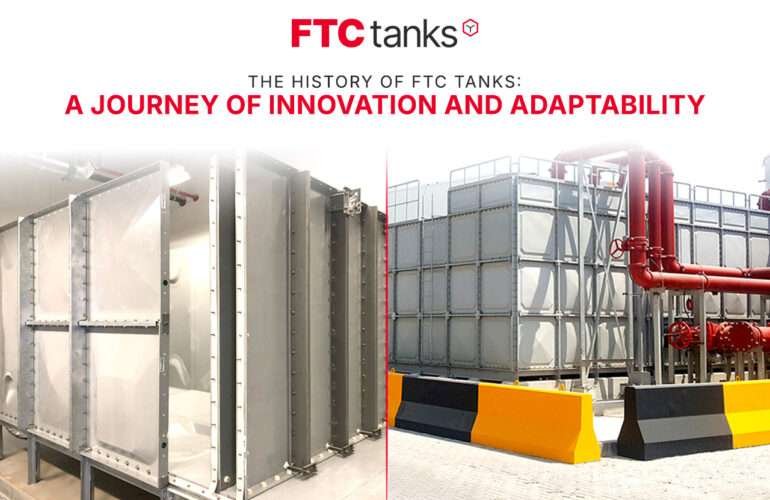Water storage is more than pipes and panels. It’s protection. When you have a reliable tank, you have security for your home, your business, and your community. Without it, daily life and emergency response both stand at risk.
At FTC Tanks, we understand that a water tank isn’t just equipment. It’s a safeguard for property, operations, and lives. If a tank fails, the consequences reach far beyond repair bills. Water quality, fire readiness, and public safety are all tied to performance.
In this guide, we’ll show you how to protect your tank and your investment. More importantly, we’ll explain why FRP water tanks are proving to be the smarter choice for long-term reliability, safety, and compliance.
Why Tank Choice Matters
The tank you choose sets the tone for everything that follows. It decides how safe your supply is, how often you’ll need repairs, and how long the system will last. Some tanks do the job for a few years. Others, like FRP tanks, keep delivering for decades.
Think about what’s at stake. A water cistern holds clean drinking water. An NFPA water tank must be ready to perform in a fire. Larger water storage tanks in towns or factories serve as emergency reserves when the unexpected happens.
Every application demands durability and trust. If a tank underperforms, it’s not just water you lose. You risk safety, compliance, and money.
Different materials promise different results. Steel can rust. Plastic can crack. Concrete can leak. Over time, these issues cost more than most expect. This is where FRP water tanks show their strength.
Tank Material Showdown
Each material has its story. Steel is strong but rusts fast. Plastic is light but struggles with harsh weather. Concrete is durable but heavy, costly, and hard to maintain. Owners have lived with these trade-offs for decades.
FRP tanks change that picture. They resist corrosion, stay strong in rough climates, and require little upkeep. They’re modular and easy to install—even on rooftops or tight spaces where other tanks simply won’t fit.
Here’s a clear look at how the options stack up:
| Feature / Material | FRP Water Tank (FTC Panel Tanks) | Steel Tank | Plastic Tank | Concrete Cistern |
| Corrosion Resistance | Excellent – corrosion-proof even in coastal/humid climates | Poor | Excellent | Fair (requires sealing) |
| Weight & Installation | Lightweight & modular, rooftop/remote install friendly | Heavy | Light | Very heavy |
| Maintenance Needs | Low – smooth panels, easy cleaning | High – needs coatings/linings | Moderate | High |
| Standards & Certification | AWWA D121-12, NFPA 22, NSF-certified options | Require Liner | Rare | Require Liner |
When you add it up, FRP water tanks deliver more value. They last longer, keep water safe, and demand less maintenance. For anyone serious about protecting their investment, they’re the practical choice.
Signs Your Tank Needs Attention
A water tank will usually tell you when it’s in trouble. The trick is catching those signs early.
Leaks are the first and most obvious warning. If you notice water loss that you can’t explain, don’t ignore it. Small leaks almost always turn into bigger ones. Another sign is sediment or cloudy water inside the system. That often points to contamination, which can put health at risk.
Look closely at the surface of your tank as well. Corrosion, cracks, or panel damage are all signs that the structure is under stress. Certifications matter too. If your tank no longer meets NSF or NFPA standards, it’s not just out of date—it may not be safe for the job it was built for.
And then there’s demand. If your current capacity can’t keep up with your needs, it’s time to act. A tank that doesn’t deliver is no longer an asset. It’s a liability waiting to happen.
Above-Ground vs. Underground Tanks
Where you place your tank matters almost as much as the tank itself. Both above ground and underground designs have their pros and cons.
- Above-ground tanks: are straightforward. They’re easier to inspect, clean, and repair. Installation costs are lower, and you don’t have to dig or disrupt the site. For most owners, this option makes the most sense.
- Underground tanks: stay protected from extreme temperatures, which can be useful in certain climates. But they come with higher installation costs, and any repairs can be complicated and expensive.
At FTC Tanks, we specialize in above-ground FRP panel tanks. They combine flexibility, long-term compliance, and simple maintenance. That balance makes them practical for homes, businesses, and large facilities alike.
Practical Steps to Protect Your Water Tank Investment
A water tank isn’t something you set and forget. To get decades of reliable service, you need a routine that keeps problems from building up.
Start with inspections. Check the outside for cracks, leaks, or panel wear. For potable water, make sure you’re using NSF-certified water tanks. For fire protection, confirm that the system meets NFPA water tank requirements. Those checks aren’t optional—they’re the backbone of safe operation.
Here’s a simple upkeep list that works for most owners:
- Inspect lids and seals to keep out debris.
- Schedule professional cleanings to prevent buildup inside.
- Track how much water you’re storing versus how much you need.
- Keep certification records (AWWA, NFPA, NSF) current and easy to find.
These small steps pay off in a big way. They extend the life of your water storage tanks, lower repair bills, and keep you compliant. The goal is simple: stay ahead of issues so your system never lets you down.
When to Upgrade: Protecting Your Budget and Compliance
Every water tank has a shelf life. Holding on to one that’s past its best years can quietly drain your budget and put you at risk of falling behind on compliance. If you’ve noticed any of these red flags, it might be time to start planning for an upgrade:
- Repairs keep piling up: If you’re calling the repair crew every few months, the tank is costing you more than it should.
- Certifications have lapsed: Outdated paperwork can put safety and compliance in question.
- Old materials showing their age: Rusting steel, cracking concrete, or linings that no longer hold up.
Switching to an FTC FRP water tank isn’t just about replacing the old—it’s about making a smart investment for the long run. Here’s why:
- They’re built to AWWA D121 and NFPA 22 standards, so you know compliance is covered.
- FTC tanks are NSF-certified for safe drinking water storage & lead-free environment.
- The modular design means you can expand the capacity later without starting from scratch.
- FRP tanks are built to last for decades with little upkeep, saving you money over time.
Upgrading shouldn’t feel like a setback. It’s a way to protect your water supply, keep your system in line with regulations, and stop wasting money on temporary fixes.
Real-World Applications of FRP Tanks
The beauty of FRP tanks is their versatility. They’re not a one-size-fits-all solution—they’re engineered to serve different needs in everyday life.
For homeowners, an FRP cistern means safe, clean water storage that won’t crack in cold weather or corrode over time. Businesses—whether it’s hotels, farms, or factories—rely on FRP water storage tanks to keep operations running smoothly without surprise breakdowns. In fire safety, NFPA water tanks are a must-have. Built to meet strict codes, they ensure you’re ready when seconds matter most. Municipalities also turn to FRP for large-scale systems, choosing them because they’re dependable, easier to maintain, and don’t eat up taxpayer budgets with constant repairs.
At FTC Tanks, we’ve seen it all—companies looking to cut downtime, towns looking for long-term infrastructure solutions. In every case, FRP proves itself as a tank you can trust.
Long-Term Payoff: Safeguarding Your Investment
An FRP water tank isn’t just a short-term fix—it’s a long-term strategy. Unlike traditional tanks that often demand constant patchwork, FRP tanks cut down on maintenance headaches and reduce the need for costly replacements. They’re engineered to stay compliant with safety and water-quality standards, so you’re not stuck scrambling when inspections roll around.
The real payoff? Peace of mind. With an FRP tank, you know your water supply is safe, your system is reliable, and your budget isn’t being drained by avoidable repairs. In the end, a tank isn’t just a container for water—it’s a core asset. Protecting it means protecting your property, your operations, and your investment.
Partner with FTC Tanks
Protecting your water tank is more than maintenance—it’s safeguarding your safety, your property, and your future. FRP tanks stand out because they’re built for resilience, compliance, and decades of dependable performance.
That’s where FTC Tanks comes in. Our team delivers state-of-the-art FRP water tanks designed to meet the toughest standards—whether it’s for fire protection, potable water cisterns, or large-scale municipal storage.
Whether you need a new fire tank, a potable water cistern, or a large-capacity water storage solution, FTC Tanks has you covered. Let’s build a system that protects what matters most. Contact us today to safeguard your investment with a tank built for tomorrow.





